Dynamic Divide Grouping Non-Orthogonal Multiple Access in Terrestrial-Satellite Integrated Network
Abstract
:1. Introduction
- To improve user access throughput, we propose a dynamic divide grouping NOMA method for TSINs. Based on the stochastic geometry theory, with the objective of maximizing the network capacity, a NOMA problem is modeled as an optimization problem of joint user grouping, power control and resource allocation.
- To ensure the effective pairing of NOMA users, by constructing the relationship model between user elevation angle, beam angle and distance, a dynamic user pairing algorithm is proposed to pair users into groups for the implementation of NOMA.
- To solve efficiently the problem, based on the instantaneous channel gain, the optimal power control factor expression is derived, then a joint optimization algorithm of beam channel and base station channel resource allocation is proposed.
2. Related Work
3. System Modeling
3.1. System Model
3.2. Problem Formulation
4. Dynamic User Pairing Method
5. Joint Resource Allocation Optimization Scheme
5.1. Power Control Factor Optimization
5.2. Satellite Beam Channel Resource Allocation
5.3. BS Channel Resource Allocation
| Algorithm 1 Satellite Beam Channel Resource Allocation. |
| 1: Initialize: ,; Initialize power ; 2: repeat 3: Initialize ,, 4: Initialize 5: repeat 6: for to do 7: Update by using (44) 8: Update by using (45) 9: end for 10: Update by using (46) and (47) 11: Set 12: Until converges 13: Set 14: Update by using (39) and (40) 15: Set 16: Until , converges |
5.4. Joint Power Allocation
| Algorithm 2 BS Channel Resource Allocation. |
| 1: Initialize: ,; Initialize; 2: repeat 3: Initialize, , 4: Initialize 5: repeat 6: for to N do 7: Update by using (55) 8: Update by using (56) 9: end for 10: Update by using (57) and (58) 11: Set 12: Until converges 13: Set 14: Update by using (51) and (52) 15: Set 16: Until , converges |
| Algorithm 3 Joint Power Allocation. |
| 1: Initialize: Initialize ,,; 2: repeat 3: for to L do 4: Update referring to Algorithm 1 5: end for 6: for to I do 7: Update referring to Algorithm 2 8: end for 9: Set 10: Set 11: Set 12: Until , converges |
6. Simulation and Analysis
6.1. Simulation Parameter
6.2. Simulation Results and Analysis
7. Conclusions
Author Contributions
Funding
Conflicts of Interest
References
- Zhou, C.; Wu, W.; He, H.; Lyu, F.; Cheng, N.; Shen, X. Deep Reinforcement Learning for Delay-Oriented IoT Task Scheduling in Space-Air-Ground Integrated Network. IEEE Trans. Wirel. Commun. 2021, 20, 911–925. [Google Scholar] [CrossRef]
- Chiu, T.; Pang, A.; Chung, W.; Zhang, J. Latency-Driven Fog Cooperation Approach in Fog Radio Access Networks. IEEE Trans. Serv. Comput. 2019, 12, 698–711. [Google Scholar] [CrossRef]
- Bi, Y.; Han, G.; Xu, S.; Wang, X.; Lin, C.; Yu, Z.; Sun, P. Software Defined Space-Terrestrial Integrated Networks: Architecture, Challenges and Solutions. IEEE Netw. Mag. 2019, 33, 22–28. [Google Scholar] [CrossRef]
- Zhu, X.; Jiang, C.; Kuang, L.; Ge, N.; Guo, S.; Lu, J. Cooperative Transmission in Integrated Terrestrial-Satellite Networks. IEEE Netw. 2019, 33, 204–210. [Google Scholar] [CrossRef]
- Sharma, P.K.; Upadhyay, P.K.; Costa, D.B.; Bithas, P.S.; Kanatas, A.G. Performance Analysis of Overlay Spectrum Sharing in Hybrid Satellite-Terrestrial Systems With Secondary Network Selection. IEEE Trans. Wirel. Commun. 2017, 16, 6586–6601. [Google Scholar] [CrossRef]
- Giordani, M.; Michele Zorzi, F. Non-terrestrial backhaul in the 6G era: Challenges and opportunities. IEEE Netw. 2021, 35, 244–251. [Google Scholar] [CrossRef]
- Cola, T.D.; Tarchi, D.; Vanelli, A. Satellite communications: Future trends in broadband information centric networks and enabling technologies. Wiley Int. J. Satell. Commun. Netw. 2015, 33, 473–490. [Google Scholar] [CrossRef]
- Choi, J. Power allocation for max-sum rate and max-min rate proportional fairness in NOMA. IEEE Commun. Lett. 2016, 20, 2055–2058. [Google Scholar] [CrossRef]
- Cui, J.; Dong, G.; Zhang, S. Asynchronous NOMA for downlink transmissions. IEEE Commun. Lett. 2017, 21, 402–405. [Google Scholar] [CrossRef]
- Cui, J.; Ding, Z.; Fan, P. A novel power allocation scheme under outage constraints in NOMA systems. IEEE Signal Process. Lett. 2016, 23, 1226–1230. [Google Scholar] [CrossRef]
- Yan, X.; Xiao, H.; An, K.; Zheng, G.; Chatzinotas, S. Ergodic Capacity of NOMA-Based Uplink Satellite Networks With Randomly Deployed Users. IEEE Access 2020, 14, 3343–3350. [Google Scholar] [CrossRef]
- Alhusseini, M.; Azmi, P.; Mokari, N. Optimal joint subcarrier and power allocation for MISO-NOMA satellite networks. Phys. Commun. 2019, 32, 2019. [Google Scholar] [CrossRef]
- Lv, L.; Ni, Q.; Ding, Z. Application of non-orthogonal multiple access in cooperative spectrum-sharing networks over Nakagami-m fading channels. IEEE Trans. Veh. Technol. 2017, 66, 5506–5511. [Google Scholar] [CrossRef] [Green Version]
- Zeng, M.; Yadav, A.; Dobre, O.A. Capacity Comparison between MIMO-NOMA and MIMO-OMA with Multiple Users in a Cluster. IEEE J. Sel. Areas Commun. 2017, 35, 2413–2424. [Google Scholar] [CrossRef]
- Xiao, Z.; Zhu, L.; Choi, J. Joint Power Allocation and Beamforming for Non-Orthogonal Multiple Access (NOMA) in 5G Millimeter Wave Communications. IEEE Trans. Wirel. Commun. 2018, 17, 2961–2974. [Google Scholar] [CrossRef] [Green Version]
- Cui, J.; Liu, Y.; Ding, Z. Optimal user scheduling and power allocation for millimeter wave NOMA systems. IEEE Trans. Wirel. Commun. 2018, 17, 1502–1517. [Google Scholar] [CrossRef] [Green Version]
- Liu, Y.; Ding, Z.; Elkashlan, M. Cooperative non-orthogonal multiple access with simultaneous wireless information and power transfer. IEEE J. Sel. Areas Commun. 2016, 34, 938–953. [Google Scholar] [CrossRef] [Green Version]
- Ding, Z.; Fan, P.; Poor, H.V. Impact of User Pairing on 5G Nonorthogonal Multiple-Access Downlink Transmissions. IEEE Trans. Veh. Technol. 2016, 65, 6010–6023. [Google Scholar] [CrossRef]
- Ali, M.S.; Tabassum, H.; Hossain, E. Dynamic User Clustering and Power Allocation for Uplink and Downlink Non-Orthogonal Multiple Access (NOMA) Systems. IEEE Access 2016, 4, 6325–6343. [Google Scholar] [CrossRef]
- Do, D.T.; Nguyen, M.; Voznak, M.; Kwasinski, A. Performance analysis of clustering car-following v2x system with wireless power transfer and massive connections. IEEE Internet Things J. 2021. [Google Scholar] [CrossRef]
- Khan, W.U.; Jameel, F.; Li, X.; Bilal, M.; Tsiftsis, T.A. Joint spectrum and energy optimization of noma-enabled small-cell networks with qos guarantee. IEEE Trans. Veh. Technol. 2021, 70, 8337–8342. [Google Scholar] [CrossRef]
- Tang, R.; Cheng, J.; Cao, Z. Contract-based incentive mechanism for cooperative NOMA systems. IEEE Commun. Lett. 2019, 23, 172–175. [Google Scholar] [CrossRef]
- Tang, R.; Cheng, J.; Cao, Z. Energy-efficient power allocation for cooperative NOMA systems with IBFD-enabled two-way cognitive transmission. IEEE Commun. Lett. 2019, 23, 1101–1104. [Google Scholar] [CrossRef]
- Do, D.T.; Nguyen, M.; Jameel, F.; Jantti, R.; Ansari, I.S. Performance evaluation of relay-aided cr-noma for beyond 5g communications. IEEE Access 2020, 8, 134838–134855. [Google Scholar] [CrossRef]
- Kim, S.; Visotsky, E.; Moorut, P.; Bechta, K.; Ghosh, A.; Dietrich, C. Coexistence of 5g with the incumbents in the 28 and 70 ghz bands. IEEE J. Sel. Areas Commun. 2017, 35, 1254–1268. [Google Scholar] [CrossRef]
- Babich, F.; Comisso, M.; Cuttin, A.; Marchese, M.; Patrone, F. Nanosatellite-5g integration in the millimeter wave domain: A full top-down approach. IEEE Trans. Mob. Comput. 2020, 19, 390–404. [Google Scholar] [CrossRef] [Green Version]
- Qi, T.; Feng, W.; Wang, Y. Outage performance of non-orthogonal multiple access based unmanned aerial vehicles satellite networks. China Commun. 2018, 15, 1–8. [Google Scholar] [CrossRef]
- Shi, X.; Thompson, J.S.; Safari, M. Beamforming with superposition coding in multiple antenna satellite communications. IEEE Int. Conf. Commun. Work. 2017, 705–710. [Google Scholar]
- Wang, L.; Wu, Y.; Zhang, H.; Choi, S. Resource Allocation for NOMA based Space-Terrestrial Satellite Networks. IEEE Trans. Wirel. Commun. 2021, 20, 1065–1075. [Google Scholar] [CrossRef]
- Zhu, X.; Jiang, C.; Yin, L.; Kuang, L.; Ge, N.; Lu, J. Cooperative Multigroup Multicast Transmission in Integrated Terrestrial-Satellite Networks. IEEE J. Sel. Areas Commun. 2018, 36, 981–992. [Google Scholar] [CrossRef]
- Zhang, H.; Jiang, C.; Wang, J. Multicast Beamforming Optimization in Cloud-Based Heterogeneous Terrestrial and Satellite Networks. IEEE Trans. Veh. Technol. 2020, 69, 1766–1776. [Google Scholar] [CrossRef] [Green Version]
- Yan, X.; Xiao, H.; Wang, C.X. Performance Analysis of NOMA-Based Land Mobile Satellite Networks. IEEE Access 2018, 6, 31327–31339. [Google Scholar] [CrossRef]
- Gao, Z.; Liu, A.; Liang, X. The Performance Analysis of Downlink NOMA in LEO Satellite Communication System. IEEE Access 2020, 8, 93723–93732. [Google Scholar] [CrossRef]
- Zhu, X.; Jiang, C.; Kuang, L.; Ge, N.; Lu, J. Non-Orthogonal Multiple Access Based Integrated Terrestrial-Satellite Networks. IEEE J. Sel. Areas Commun. 2017, 35, 2253–2267. [Google Scholar] [CrossRef]
- Lin, Z.; Lin, M.; Wang, J.B. Joint Beamforming and Power Allocation for Satellite-Terrestrial Integrated Networks with Non-Orthogonal Multiple Access. IEEE J. Sel. Top. Signal Process. 2019, 35, 657–670. [Google Scholar] [CrossRef] [Green Version]
- Yan, X.; Xiao, H.; Wang, C.; An, K. Outage performance of NOMA-based hybrid satellite-terrestrial relay networks. IEEE Wirel. Commun. Lett. 2018, 7, 538–541. [Google Scholar] [CrossRef]
- Yan, X.; Xiao, H.; An, K.; Zheng, G.; Tao, W. Hyrid satellite terrestrial relay networks with cooperative non-orthogonal multiple access. IEEE Commun. Lett. 2018, 22, 978–981. [Google Scholar] [CrossRef] [Green Version]
- Zhang, X.; Guo, D.; An, K. Performance Analysis of NOMA-Based Cooperative Spectrum Sharing in Hybrid Satellite-Terrestrial Networks. IEEE Access 2019, 7, 172321–172329. [Google Scholar] [CrossRef]
- Andrews, J.G.; Baccelli, F.; Ganti, R.K. A tractable approach to coverage and rate in cellular networks. IEEE Trans. Commun. 2011, 59, 3122–3134. [Google Scholar] [CrossRef] [Green Version]
- Arti, M.K. Channel estimation and detection in satellite communication systems. IEEE Trans. Veh. Technol. 2016, 65, 10173–10179. [Google Scholar] [CrossRef]
- Lutz, E.; Werner, M.; Jahn, A. Satellite Systems for Personal and Broadband Communications; Springer Science & Business Media: Berlin/Heidelberg, Germany, 2012. [Google Scholar]
- Zheng, G.; Chatainotas, S.; Ottersten, B. Generic optimization of linear precoding in multibeam satellite systems. IEEE Trans. Wirel. Commun. 2012, 11, 2308–2320. [Google Scholar] [CrossRef] [Green Version]
- Gradshteyn, I.S.; Ryzhik, I.M. Table of Integrals, Series, and Products; Academic Press: New York, NY, USA, 2007. [Google Scholar]
- Abdi, A.; Lau, W.; Alouini, M.S. A new simple model for land mobile satellite channels: First-and second-order statistics. IEEE Trans. Wirel. Commun. 2003, 2, 519–528. [Google Scholar] [CrossRef] [Green Version]
- Ding, Z.; Schober, R.; Poor, H.V. A general MIMO framework for NOMA downlink and uplink transmission based on signal alignment. IEEE Trans. Wirel. Commun. 2016, 15, 4438–4454. [Google Scholar] [CrossRef] [Green Version]
- Boyd, S.; Vandenberghe, L. Convex Optimization. IEEE Trans. Autom. Control 2006, 51, 1859. [Google Scholar]
- Chen, Z.; Guo, D.; An, K. Efficient and Fair Resource Allocation Scheme for Cognitive Satellite-Terrestrial Networks. IEEE Access 2019, 7, 145124–145133. [Google Scholar] [CrossRef]
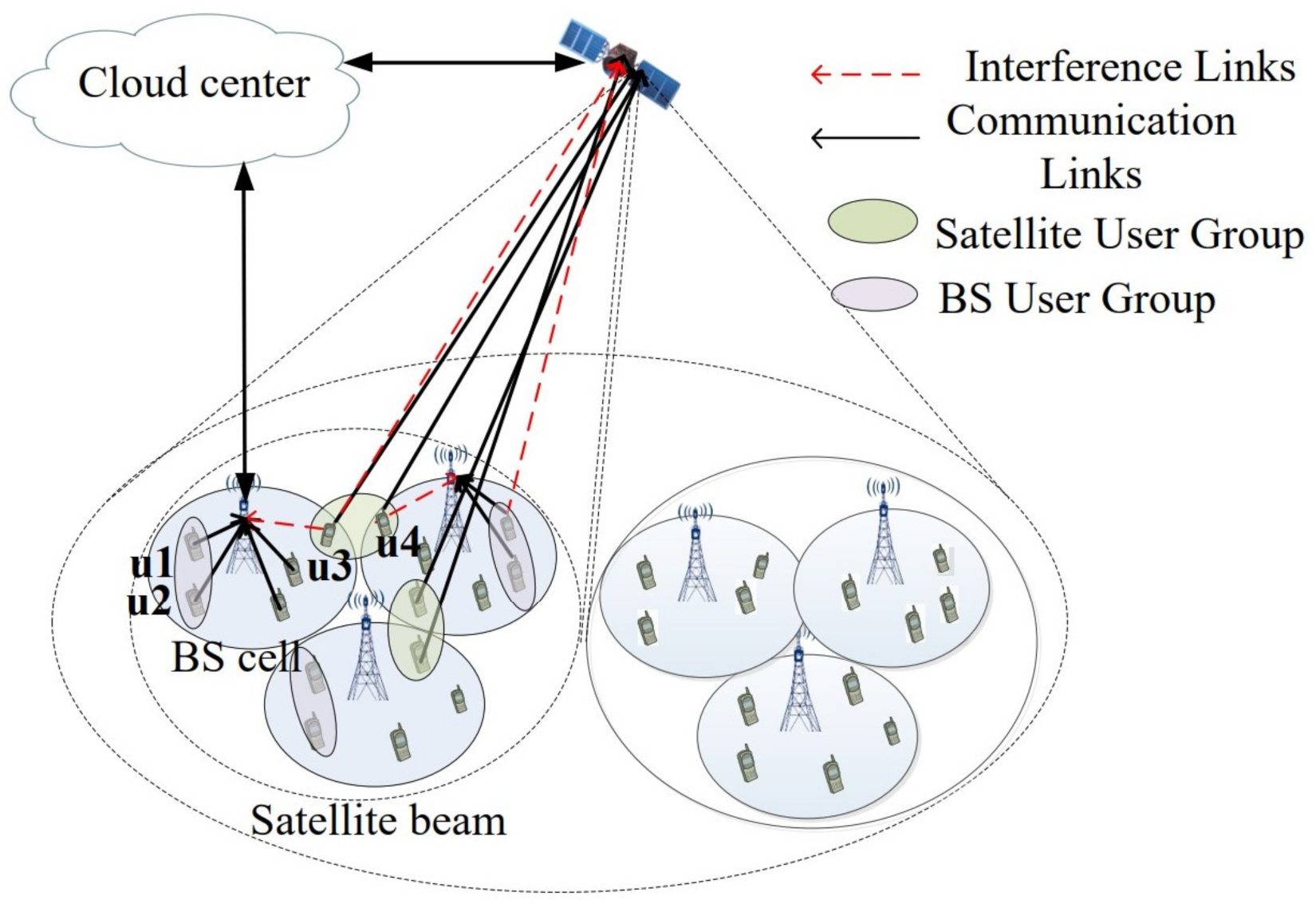
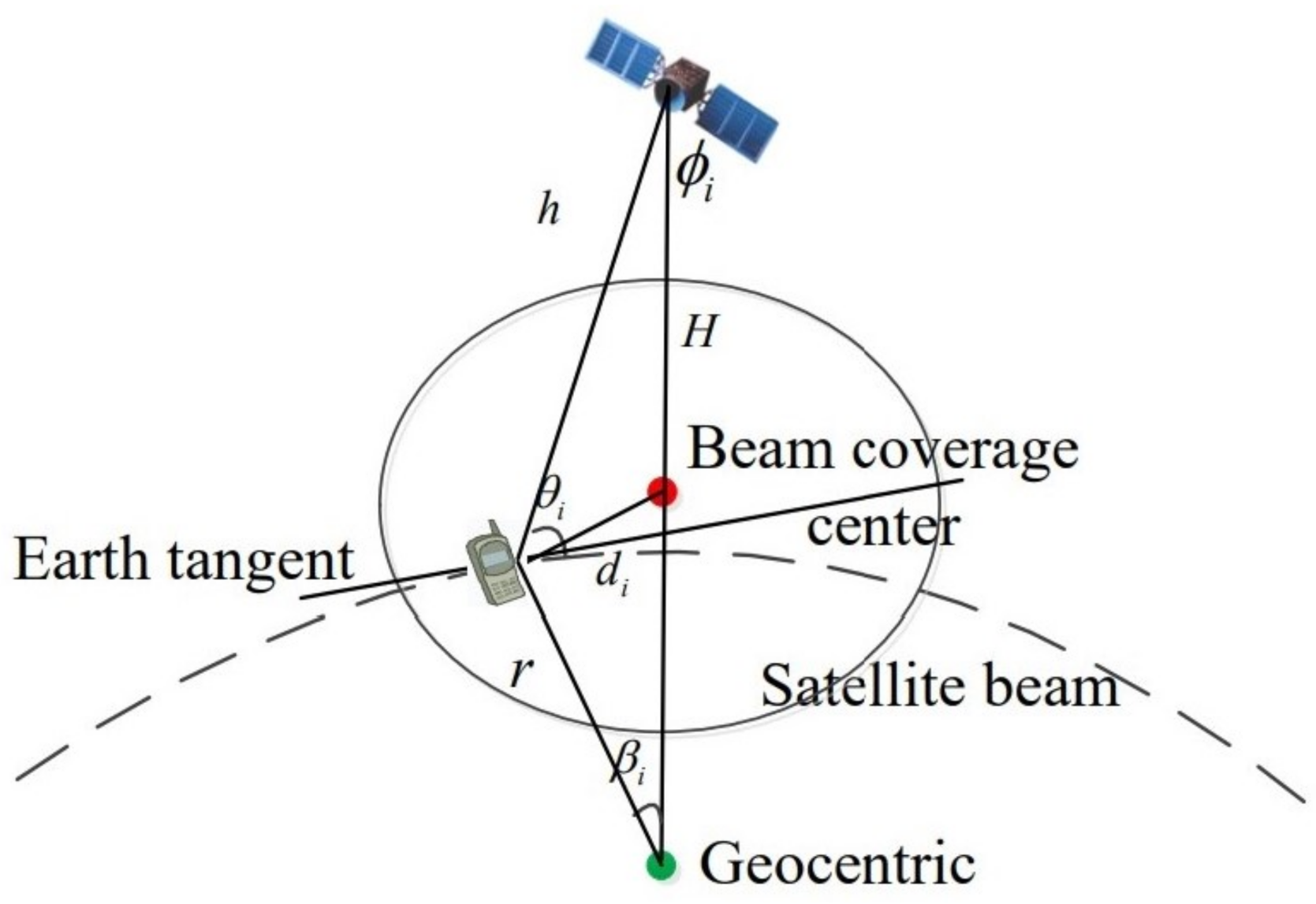
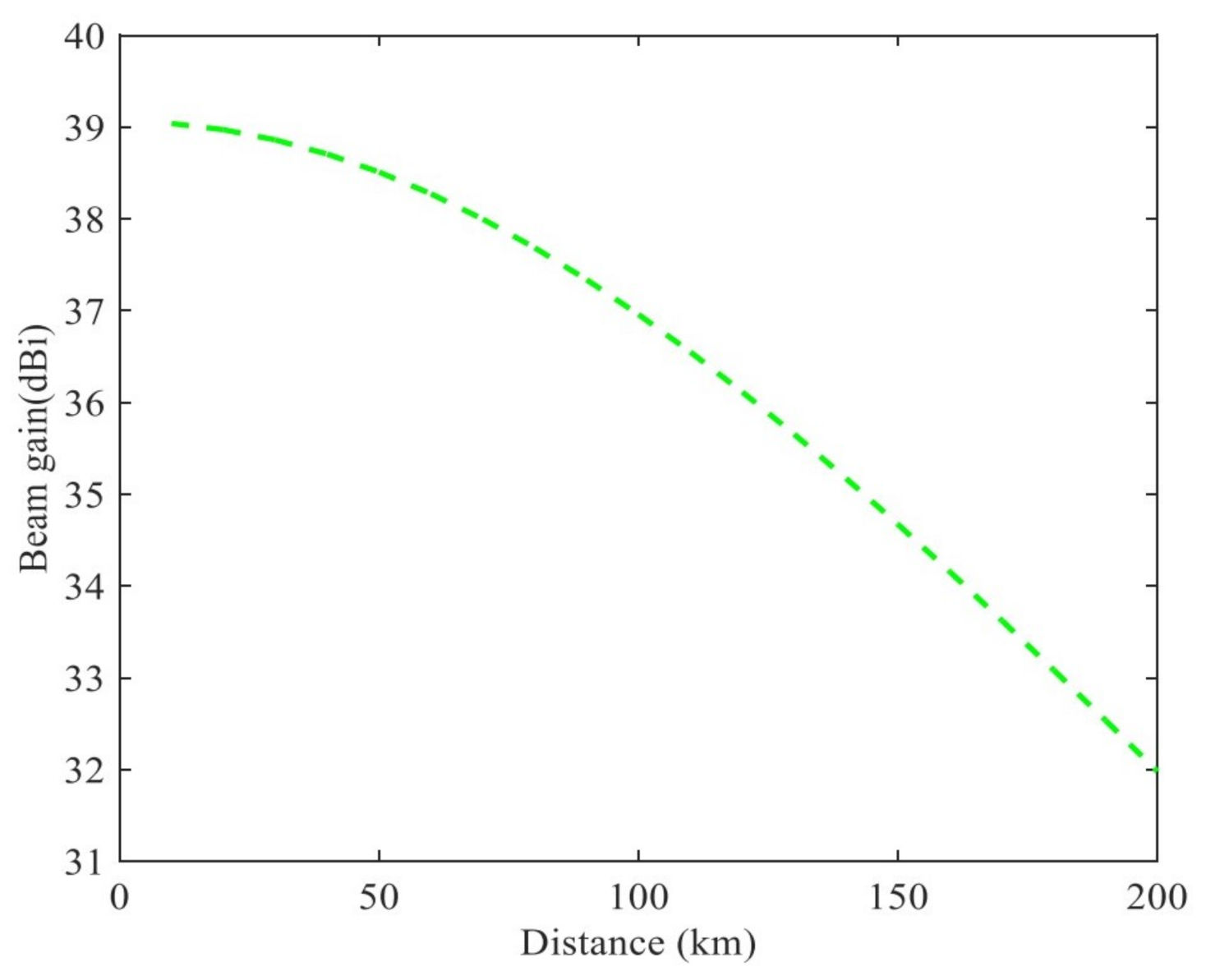
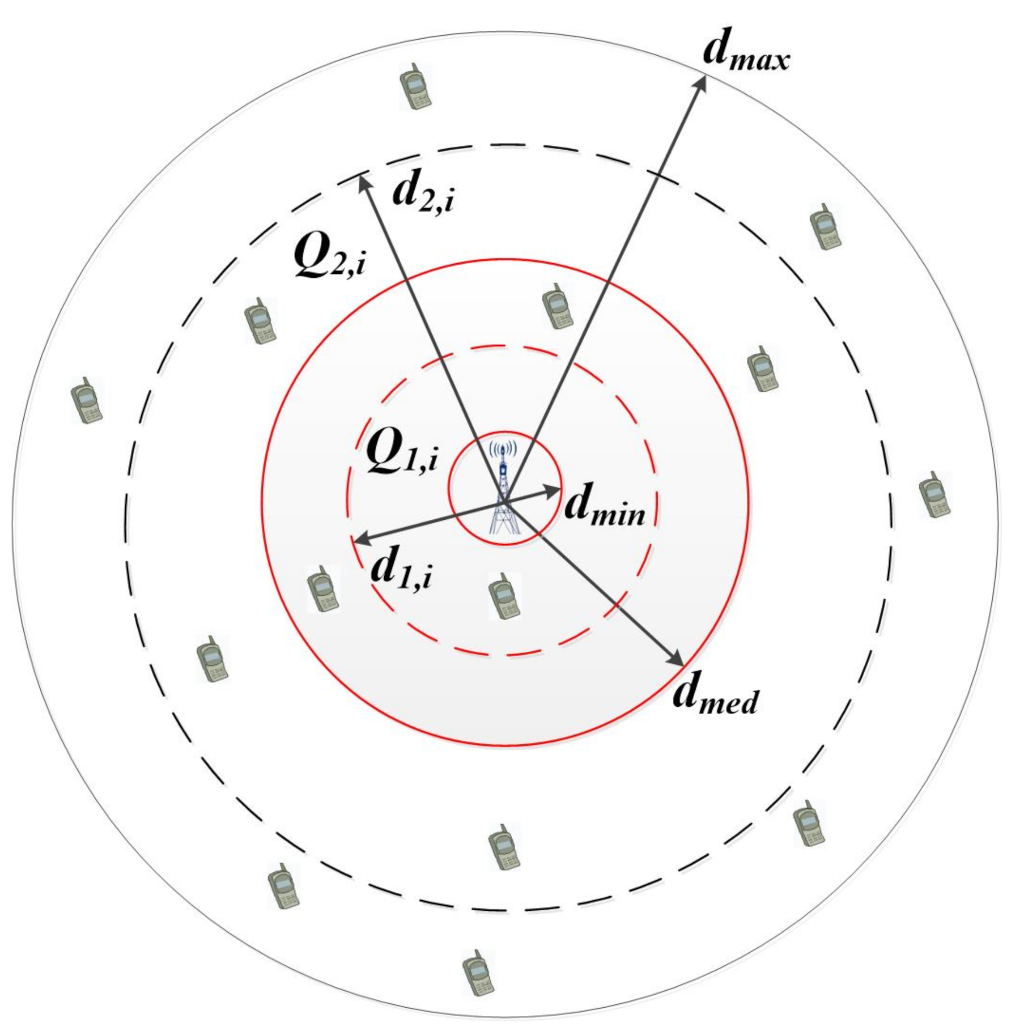
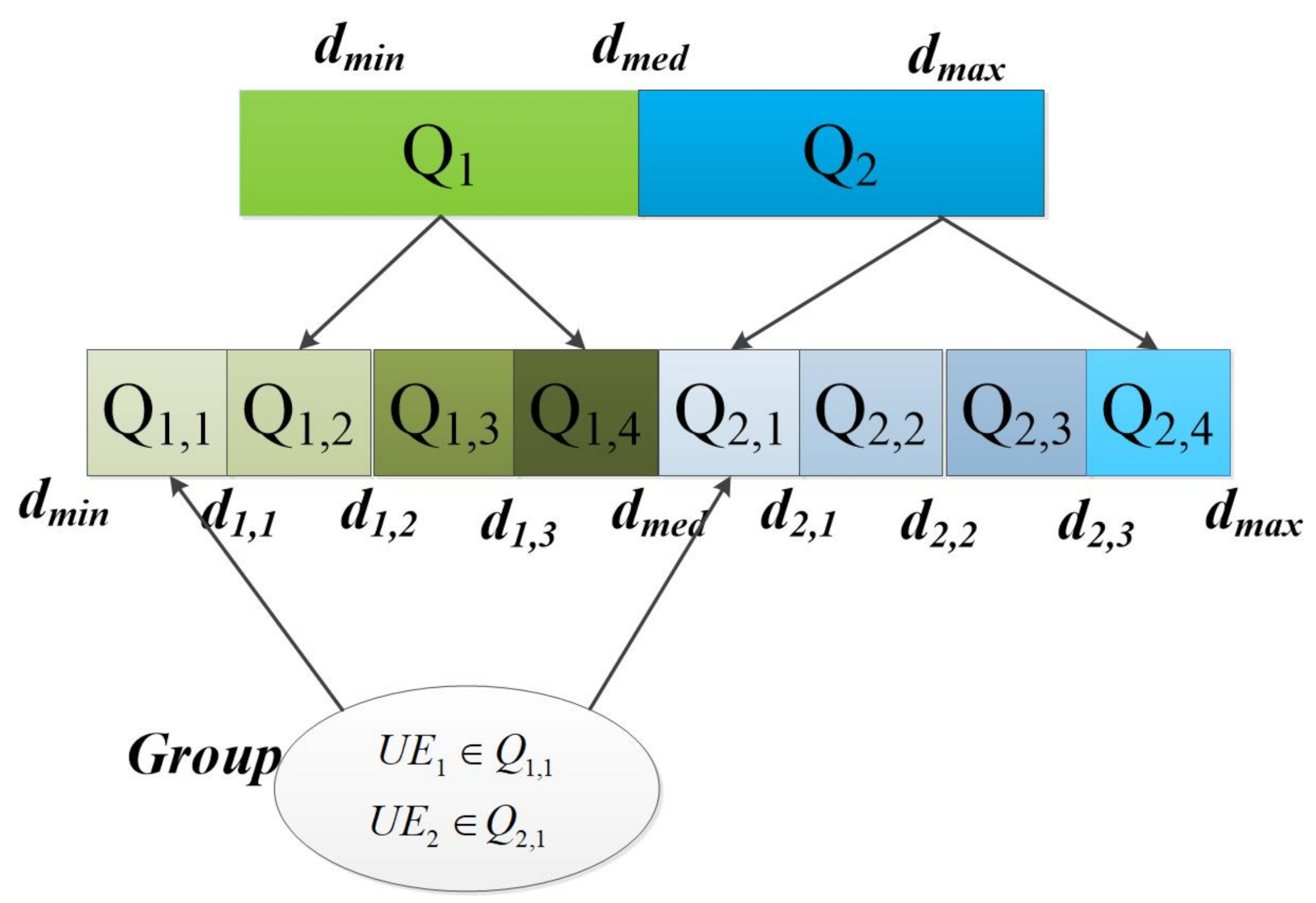



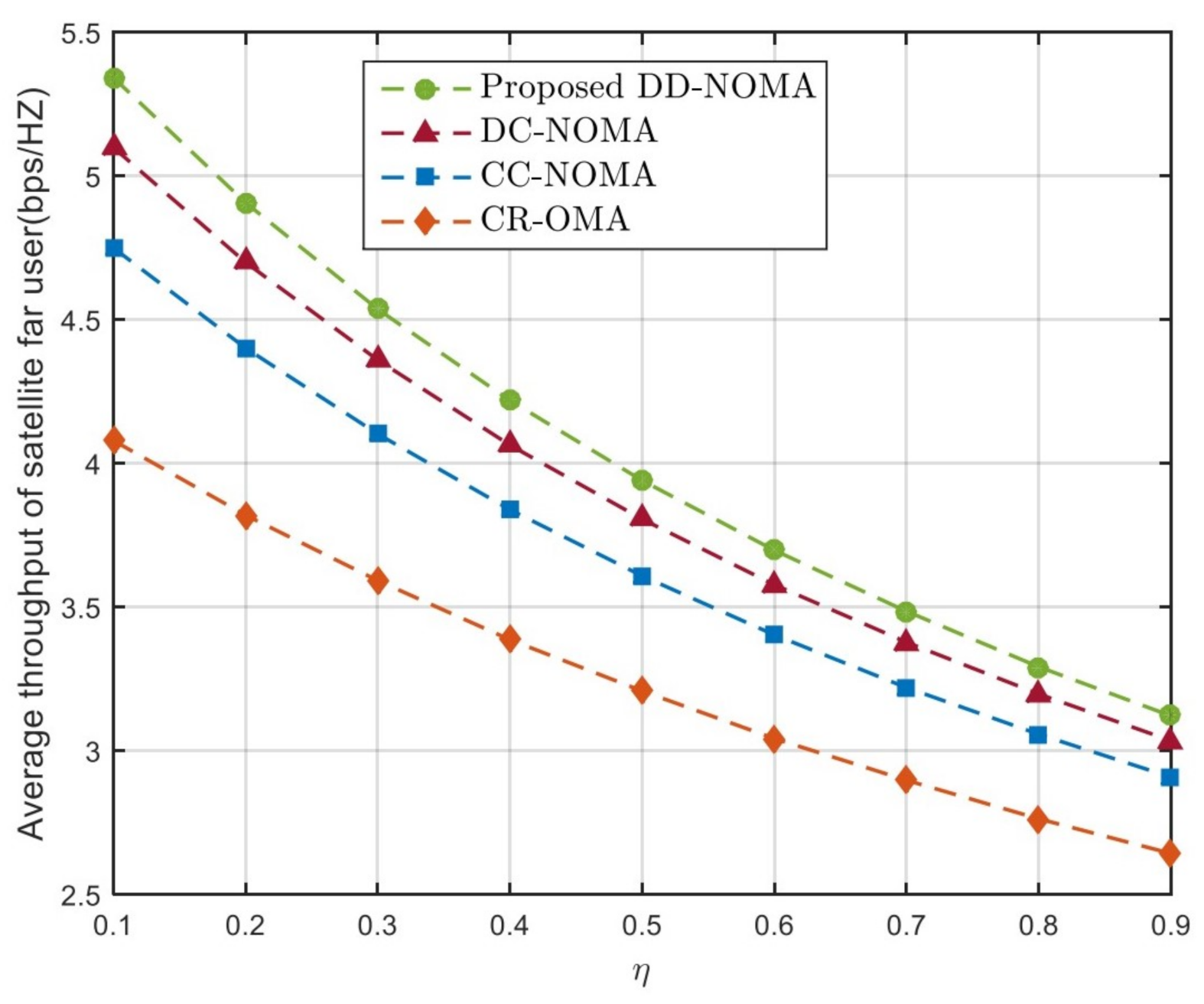

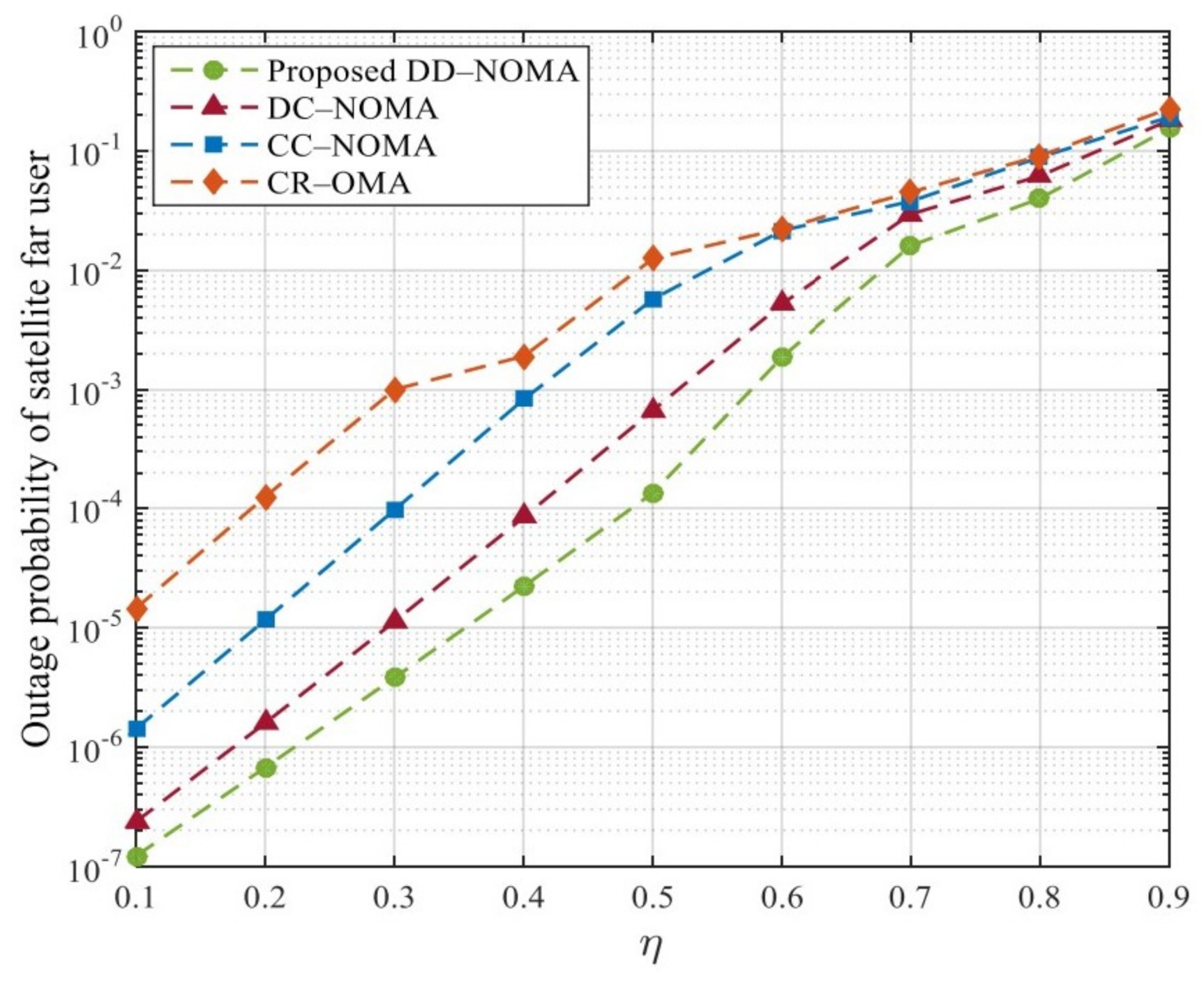
| Reference | System Model | Usering Pairing | Optimization Method | Limitations |
|---|---|---|---|---|
| [15,16] | Multi BS cell + K users | Mean clustering | Branch-and-bound method | Fixed power allocation lead to suboptimal solution |
| [18] | Multi BS cell + K users | Greedy algorithms | Pareto-boundary commuted using reformulation | Fixed power allocation lead to suboptimal solution |
| [20] | Multi BS cell + K vehicles | Random | Analytic techniques | Channel difference of user pairing cannot be guaranteed |
| [21] | Multi BS cell + K users | Random | Successive convex approximation | Random user pairing will affect the transmission rate of users |
| [24] | Cognitive radio networks | Random | Analytic techniques | No user pairing method and CR introduces signal interference between networks |
| [26] | A fixed satellite + BS + k users | No | Slotted Aloha method | Users number is limited by OMA method |
| [27] | Satellite + k UAVs | Random | Heuristic algorithm | Random user pairing will affect the transmission rate of UAV |
| [28] | Satellite + k users | Random | Iterative optimization algorithm | Channel difference of user pairing cannot be guaranteed |
| [29] | Satellite + k users | Channel correlation coefficient | A suboptimal algorithm based on alternate direction | User pairing method will not guarantee stable pairing relationship |
| [30] | Fixed satellite + k earth stations | Stagger and fold method | Taylor expansion and penalty function methods | The impact of satellite time-varying links on user pairing isnot analyzed |
| [34] | Satellite + BS cell + K users | Channel correlation coefficient | Iterative scheme based on Karush-Kuhn-Tucker approaches | User pairing method will not guarantee stable pairing relationship |
| Parameters | Values |
|---|---|
| Orbital altitude | 1000 km |
| Number of beams | 5 |
| BS number of beam coverage | 10 |
| Number of BS subchannels | 10 |
| Number of beam subchannels | 50 |
| User terminal height | 1.5 m |
| BS height | 10 m |
| Coverage radius of BS | 5 km |
| Coverage radius of beam | 50 km |
| The maximum power of group | 18 dBm |
| Satellite antenna gain | 25 dBi |
| BS antenna gain | 17 dBi |
| User antenna gain | 0 dBi |
| Noise power spectral density | −174 dBm/HZ |
Publisher’s Note: MDPI stays neutral with regard to jurisdictional claims in published maps and institutional affiliations. |
© 2021 by the authors. Licensee MDPI, Basel, Switzerland. This article is an open access article distributed under the terms and conditions of the Creative Commons Attribution (CC BY) license (https://creativecommons.org/licenses/by/4.0/).
Share and Cite
Yan, Y.; Xu, H.; Zhang, N.; Han, G.; Liu, M. Dynamic Divide Grouping Non-Orthogonal Multiple Access in Terrestrial-Satellite Integrated Network. Sensors 2021, 21, 6199. https://doi.org/10.3390/s21186199
Yan Y, Xu H, Zhang N, Han G, Liu M. Dynamic Divide Grouping Non-Orthogonal Multiple Access in Terrestrial-Satellite Integrated Network. Sensors. 2021; 21(18):6199. https://doi.org/10.3390/s21186199
Chicago/Turabian StyleYan, Yanjun, Huihui Xu, Ning Zhang, Guangjie Han, and Mingliu Liu. 2021. "Dynamic Divide Grouping Non-Orthogonal Multiple Access in Terrestrial-Satellite Integrated Network" Sensors 21, no. 18: 6199. https://doi.org/10.3390/s21186199
APA StyleYan, Y., Xu, H., Zhang, N., Han, G., & Liu, M. (2021). Dynamic Divide Grouping Non-Orthogonal Multiple Access in Terrestrial-Satellite Integrated Network. Sensors, 21(18), 6199. https://doi.org/10.3390/s21186199







